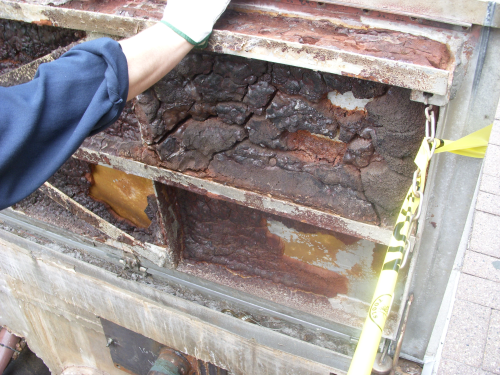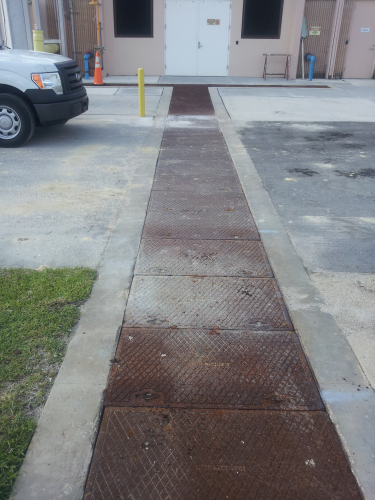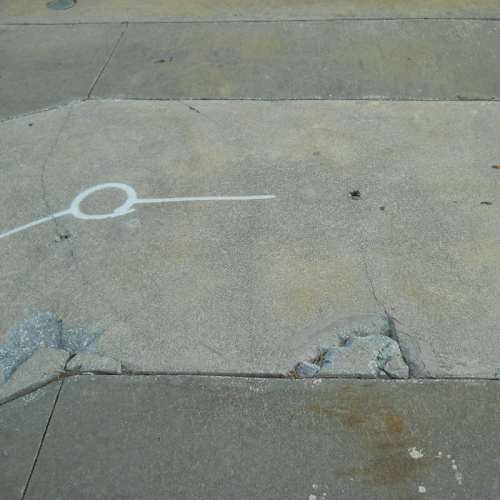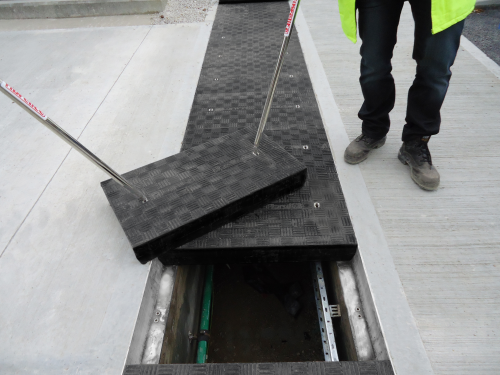




A major issue that faces ageing underground infrastructure and one of the principal factors related to the deterioration of infrastructure is corrosion.
The traditional materials used to make manhole covers and trench covers for underground infrastructure are steel, cast iron and concrete. All of these materials, including, to a lesser extent concrete, are subject to corrosion.
When manhole covers or grates are used in areas with vehicular access, they must be capable of bearing heavy loads. Load bearing manhole covers or grates are typically constructed from cast iron. In particular, ductile cast iron (cast iron with added magnesium) has been used for manhole covers and frames since the 1950s for its durability, ductility and high compressive strength.
The engineering community in particular engineers designing underground infrastructure, rarely considered any reason to use an alternative material than cast iron for manhole covers or related products.
High costs of occupational injuries
As manhole and trench covers are used to access underground systems and piping, they are a key component in the infrastructure of water distribution and water treatment facilities as well as in industries that include electrical utilities, telecommunications and energy companies, for example. Given their prevalence in underground infrastructure, it is obvious that manhole covers are handled frequently by individuals involved in maintaining such systems. While cast iron manhole covers provide for a highly durable, strong product capable of standing up to heavy loads and severe impact, the weight of cast iron creates its own problems. When a manhole cover weighing that much is removed using traditional tools and lifting techniques, it has the potential to cause a multitude of injuries to the individual or individuals attempting to remove it. The types of injuries caused by heavy castings are numerous and can be quite severe: lacerations, amputations of fingers and toes, broken bones, repeated muscle strains and sprain, wrenched backs and repetitive trauma caused by improper lifting techniques.
Corrosion resistant materials
As the underground systems currently installed are retrofitted or upgraded and new facilities are designed, engineers are moving towards specifying corrosion resistant materials in the place of steel, cast iron and concrete.
This is particularly true in underground infrastructure that is located in areas that are more prone to corrosion (coastal regions or colder areas where salt is commonly used as a de-icing agent) or in infrastructure applications that store or convey water, wastewater or corrosive liquids.
Such piping systems are common in the sewer and wastewater treatment industries as well as the petrochemical, pharmaceutical and pulp and paper industries.
GRP composites
Glass reinforced plastic (GRP) products are now being widely used for applications where corrosion can destroy underground infrastructure.
A prime reason for using GRP products is because of their inherent corrosion resistance. In many cases, they are the only materials that will handle a given service environment and in other cases their corrosion resistance is combined with their lower unit cost to make them the most economical acceptable solution (for example, when compared to high grade stainless steel).
Corrosion resistance of GRP is a function of both the resin content and the specific resin used in the laminate. There are various resin systems available which provide long-term resistance to almost every chemical and temperature environment. Optimum corrosion resistance is achieved by the appropriate resin selection and laminate construction.
Covered trenches
In applications involving highly corrosive or environmentally damaging liquids, engineers often design concrete trenches to contain the piping. Such trenches act as secondary containment and will prevent a release from entering the surrounding environment; in addition, they allow for easy inspection of and access to the primary piping. In many of the trench applications installed at water and sewage treatment plants the covered trenches must be capable of being trafficked by heavy forklifts and vehicles. Covers for heavy wheel loads in the UK are usually constructed of reinforced concrete, steel or cast iron or a combination of these materials. While concrete, cast iron or steel trench covers are indeed capable of supporting heavy loads, they present a number of problems to the operators of the facilities where they are installed as the primary purpose of the trench is to allow for accessibility to and easy inspection of the piping or cabling within the trench, then removal and replacement of the panels is of great importance when considering the design of the trench. In addition to the heavy weight of concrete, steel and stainless steel trench panels, such materials are subject to degradation over time that can weaken or destroy the panels. Concrete can be damaged by aggregate expansion, exposure to salt water or chemicals such as sulphuric acid. Hydrogen sulphide, commonly known as sewer gas, is present in all sewage collection or treatments systems. The hydrogen sulphide can be oxidised into sulphuric acid by bacteria living on the concrete surface above the water level in the sewer system. The sulphuric acid dissolves the carbonates in the cured cement and causes strength loss, as well as producing sulphates which are also harmful to concrete.
As concrete weakens from exposure to external stimuli, it becomes weaker and more likely to crack or crumble. If load bearing concrete trench panels begin to break down and degrade over time, the panels will need to be repaired or replaced before they fall apart or are no longer able to support vehicle weights.
A safer alternative
One of the first to explore alternatives to cast iron manhole covers were the major oil companies operating service stations. In an effort to reduce employee injuries, these companies became interested in replacing their cast iron covers installed above underground fuel storage tanks with lighter composite covers.
The covers used at a typical service station or fuelling facility are removed often in order to fill the tanks with fuel and for inspection and maintenance. Due to the frequency of removal and replacement, employees and contractors at the service stations used to experience a significant amount of occupational injuries caused by handling the heavy steel covers. These injuries typically included hand and foot trauma, back pain and muscle and ligament strains.
Fibrelite responded to the needs of the retail petroleum industry with a lightweight composite cover designed to be removed and replaced with a lifting handle that allowed the cover to be pulled out of the frame. Working with structural and composites engineers from one of the leading universities in the UK, Fibrelite designed a GRP cover that could support the same wheel loads as a cast iron manhole cover while weighing one third of the weight or less. The lightweight cover and ergonomic method of removal and replacement eliminated the possibility of injury to the employees or individuals handling the covers.
Water industry
Water companies are looking to invest in products which will last longer with minimal maintenance. The key factors when considering composite covers are durability, versatility performance and cost. What makes a product innovative is that the design allows for complete flexibility while retaining the necessary strength and resistance to environmental factors.
Fibrelite says that its covers are load tested up to 90 tonnes and come in a variety of sizes. With lightweight properties and innovative lifting handles for site workers these covers aid manual handling issues and are secure systems against theft or tampering.
EMI and RF signals
There are a number of ‘high tech’ applications requiring composite covers that are being driven by the need to transmit data or energy through the surface of a cover. In addition to being far less conductive than metal or cast iron covers, composite covers also allow electromagnetic (EMI) or radio frequency (RF) signals to pass directly through them. Metal or cast iron covers will shield such signals and therefore will prevent any transmission of energy or data. By allowing EMI or RF energy to pass through the cover, composite covers are now allowing engineers to install sensors and other devices inside a manhole that can then communicate to a receiver or network located aboveground.
Composite covers are also being used in wireless electric vehicle charging systems that are designed to be installed underground in parking lots. These systems will transmit power to the car battery parked overhead via an electric coil placed inside a composite manhole cover – this method of transmitting power allows for much faster vehicle charging than traditional cable charging as there is no power lost due to the resistance of the cable.
Customised and coloured covers
Company logos and other brand markings can also be included on covers. Any style logo or other marking can be permanently moulded into the upper surface of the cover in single or multiple colours. This can be for additional brand or product identification, or to blend in with the colour or layout of a facility.
A supplier for the construction market, such as Fibrelite, offers both standard as well as bespoke solutions. For normal applications where the covers will be subjected to temperatures up to 50°C and non corrosive environments, a polyester-based resin system can be used. For applications where the covers would be exposed to corrosive chemicals, steam or be subjected to higher temperatures the company would use a vinyl ester-based resin system. For bespoke projects the glass layup will be optimised according to the dimensions of the covers and the required local ratings specified. |
By introducing pigment directly into the composite resin during the closed moulding process, Fibrelite says that it ensures that the colour is not merely applied on the surface of the cover. Instead, the colouring is evenly and completely infused throughout the composite cover and will not fade or wear over time.
The marking and colouring process can be used to identify underground systems in a unique and highly visible way. It can be a quick and reliable method of identifying underground systems thereby providing maintenance or emergency personnel with more accurate information about any hazards or special conditions related to the underground infrastructure.
Case studies
Composite manhole covers have been specified for use in highly corrosive environments such as steam manhole vaults. In many major cities, district energy networks operate large underground piping systems used to transmit steam from a central plant to nearby office buildings, hotels, hospitals and apartments. The steam or superheated steam that is transmitted in such systems can often reach temperatures as high as 300°F/149°C. Due to the high heat of the steam, many utilities require the use of a thermally non-conductive composite manhole cover to prevent the accidental burning of pedestrians that may come in contact with the cover.
In a water treatment facility, a combination of failing fall-restraints and cover segments weighing in excess of 70kg made the health and safety risks unacceptable on a combined sewer overflow (CSO) site. Following research into various alternatives, the water company saw composite covers as the way to eliminate on-site dangers associated with their metal manhole and trench access. With no need for hinges or mechanical parts there is no potential for failure and no requirement for ongoing maintenance for the GRP composite trench cover and the weight does not exceed 25kg. ♦
This article was published in the January/February 2014 issue of Reinforced Plastics magazine.
The digital edition of Reinforced Plastics is distributed free of charge to readers who meet our qualifying criteria. You can apply to receive your free copy by completing this short registration form.






